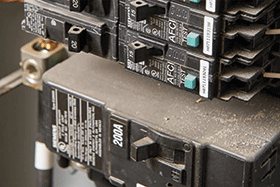

Voltage sags, tripping breakers, overheated electrical panels, and excessive voltage levels indicate possible trouble in an electrical distribution system. Where do you begin the search to isolate the exact cause of these power quality problems? As a common point for branch circuit distribution, the service panel is a convenient place to take the pulse of your electrical system. Several problems can be located right in the service panel itself. For issues elsewhere in the system, measurements at the service panel can tell you where to look next. A quick visual inspection can catch some problems, while others require that measurements to be taken.
This article outlines a step-by-step process for locating and fixing potential trouble spots. Various tools can be used for power quality troubleshooting, from digital multimeters to handheld single- and three-phase power quality analysers that perform many calculations automatically.
Voltage level and stability
The first step in checking to see if voltage levels and stability are the culprits is to measure voltage levels of the branch circuits at the load side of the branch circuit breakers. If voltage levels are low at the breaker, they will be even lower at the receptacle. This could be caused by low tap settings at the transformer. Other likely culprits include loose connections, long feeder runs and overloaded transformers, which create excessively high source impedance.
If intermittent voltage sags are suspected, start at the panel to isolate the cause. Are the sags the result of loads on the same branch circuit, or are they caused by loads elsewhere in the distribution system? We can start isolating the source with a multi-channel recording instrument such as the Fluke power quality analyser, which can monitor trends in voltage and current simultaneously.
Upstream, downstream
What information are you looking for from the trend plots? If a voltage sag occurs simultaneously with a current surge, it is caused by a load on the branch circuit. The cause of the sag is downstream of the measurement point, and therefore can be regarded as a load-related disturbance.
If, on the other hand, the voltage sag coincides with a very small change in current, the sag was likely caused by something upstream of the measurement point and can be thought of as a source-related disturbance. Typically these are heavily loaded three-phase motors started across the line, or sags originating on the utility feed. If the sag approaches an outage, the cause is more likely to be the utility. The event probably reflects a fault and breaker trip, followed by automatic breaker reclosure.
Current balance and loading
To check the current balance and loading, measure each feeder phase and current on each branch circuit. It is critically important to use a true-rms clamp or true-rms digital multimeter with a clamp-on accessory. An average responding clamp-on meter will not provide an accurate measurement, as the combination of fundamental and harmonic current makes this a distorted waveform. A lower cost average-sensing meter will tend to read low, leading you to assume that the circuits are more lightly loaded than they are.
Harmonics
To check for the presence and level of harmonics, measure the current on the feeder neutral. This will typically be in the 80 to 130% range of the feeder current, because the third harmonic will add up in the neutral.
Grounding
Neutral ground bonds in subpanels are a violation of the NEC, and of power quality performance wiring. Neutral ground bonds should be made at the transformer, even though the NEC permits it to be made at the main panel. It should never be made downstream of the main panel, whether at a subpanel or a receptacle. When a neutral ground bond is made at a subpanel or receptacle, the ground path becomes a parallel return path for normal load current, resulting in measurable current on the ground.
Hot spots
Poor connections and the resulting heat losses are the single most significant source of system inefficiency. Loose terminations contribute significantly to excessive source impedance. Fortunately, they are easy to locate with a simple infrared thermometer. Infrared measurements with tools like the Fluke 60 Series are a safe and effective technique for the non-contact detection of panel hot spots.
Circuit breakers
Measurements of circuit breaker voltage drop can help us determine the condition of the breaker. Measure across the line-to-load side of the branch breaker. If the voltage drop exceeds 100 mV, the breaker should be replaced.
In summary, the service panel is the crossroads of the building’s electrical system. From here an experienced electrical troubleshooter can locate and fix any problems.
Product: https://bit.ly/3sQ4GQ4
| Tel: | +27 10 595 1824 |
| Email: | [email protected] |
| www: | www.comtest.co.za |
| Articles: | More information and articles about Comtest |

© Technews Publishing (Pty) Ltd | All Rights Reserved